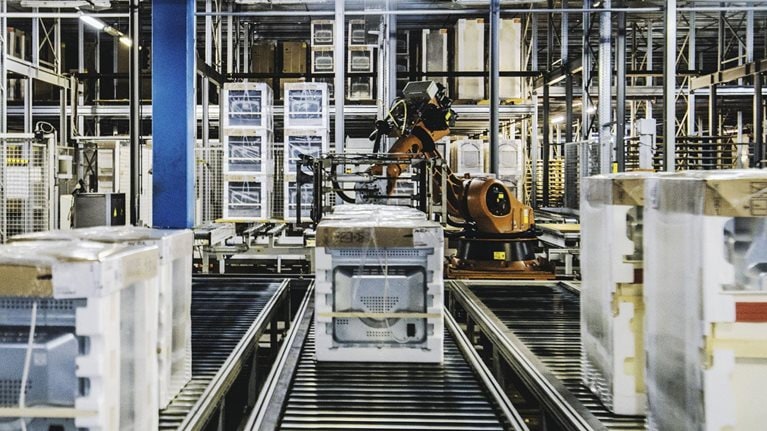As coronavirus continues to spread, industrials are struggling to protect their employees and support government efforts to mitigate the humanitarian crisis. Simultaneously, they are trying to preserve their business and the livelihoods of workers in a world that changed almost overnight.
Already, the pandemic has altered demand patterns, customer spending, and end markets—and that makes the ability to redesign products quickly even more essential to a company’s long-term survival. But many industrials take months to years to refresh their products or correct quality or manufacturing issues, such as high repair rates. Adding to the problem, many industrials only budget to upgrade a small portion of their portfolio each year, even if the external environment radically changes. If these practices continue, slow-moving companies will not meet customer needs during the pandemic, nor will they be the first-choice provider once the coronavirus is contained and businesses potentially encounter a wave of pent-up demand.
Some industrials have attempted to accelerate product improvement through lengthy R&D reorganizations or engineering-process overhauls, but they might achieve better results through a new approach termed Rapid Product Improvement (RPI). By minimizing bureaucracy, streamlining work, and creating a truly cross-functional process, RPI can reduce the time required for product redesign by two- to threefold. This approach can be adapted for remote work and may improve employee morale by keeping the focus on next-generation products while working in new and exciting ways.
Several actions, which we termed launch accelerators, can help companies successfully implement RPI (Exhibit 1). Several of these elements are based upon well-known lean, agile, and design-to-value principles, but RPI calls for integrating and applying them more rapidly and intensely, using practical tools and insight-gathering techniques adapted for this purpose. RPI also increases unity because it requires both constant interaction among stakeholders and formal working sessions at major decision points.

Creating and empowering a small cross-functional task force
The first step in RPI involves creating a small cross-functional task force whenever the need for product improvement becomes clear, including instances where competitors are upping their game or the external environment has changed.
Although companies frequently create cross-functional teams, few ensure that they have the correct staffing, as well as clear alignment on goals. Those oversights often result in a dysfunctional team that encounters multiple problems, including budget overruns, schedule delays, and a failure to align with company goals. In one study, 75 percent of teams fell into the dysfunctional category.1
Team composition is a major factor in dysfunction. Even when company leaders emphasize that they want the right mix of people, they default to picking members based primarily on job title or seniority. In our experience, teams will function better if their members are selected based on a combination of technical knowledge and more intangible characteristics, such as the ability to collaborate and integrate a wide range of perspectives when solving problems. In addition to making the group function better, team members with these skills help create an atmosphere of psychological safety—one in which participants feel comfortable challenging current and past practices, asking questions, taking risks, and assuming new roles.2
One of the most important staffing decisions relates to task-force leadership. For best results, the leader should have robust project-management skills and the ability to facilitate collaboration between functions. What’s most essential is an openness to creative solutions and new ways of working, as well as an impartial, fact-based orientation. The task-force leader may be a product or project manager from engineering or R&D, as is often the case, but staff from other roles may also be effective.
In addition to the leader, the task force should include an individual deputized from each corporate, business, and functional group with product impact. These members will not simply serve as advocates for their own groups or set functional goals; instead, they should focus on the unique and shared objective of improving the product at hand, as rapidly as possible. To get the necessary speed, company leaders should empower teams to make decisions, with functional executives assisting as needed. Initially, teams may feel uncomfortable with this process because they are moving much more quickly than usual. But they will still be meeting all regulatory, safety, and quality guidelines—just at a much faster rate.
For more advice on assembling a team, see the sidebar “Tactical suggestions for cross-functional task forces.”
Would you like to learn more about our Advanced Electronics Practice?
Rapidly gathering actionable insights
Before any development work commences, companies will gather updated information on relevant topics across three lenses: their customer needs, the competitive landscape, and the supply chain. Although most companies collect such insights, the efforts are typically done in isolation, with few departments sharing information promptly and effectively. In the RPI approach, task-force members pull this information and continually share it with others. Through these exchanges, the task force can define and prioritize what product features or attributes to research. They can also adjust and pivot along the way as new information comes in (Exhibit 2).

Discovering what target customers want—and their willingness to pay
The task force must first understand the pain points, unmet needs, and priorities of their target customers. The goal is to synthesize the data and obtain actionable insights that will help design teams prioritize the product features that require the most urgent upgrades or performance adjustments, as well as those that can be changed to reduce costs. Beyond product features, task-force members will also learn about other potential issues that may concern customers, such as the availability of spare parts, and investigate possible solutions.
Using new techniques, task-force members can get the required customer data within days, rather than weeks and months. Two complementary sources are critical during this process:
- Direct observations of customers using products in different settings. Task-force members can conduct field visits in which they see customers interacting with current products to gain insights about design and desirable features.
- Direct inputs from customers and other stakeholders. Task-force members should gather data on current customers, those who purchase competing products, and core influencers across the value chain. They can collect this information quickly during structured interviews, surveys, and facilitated workshops. For companies that manufacture B2C products, even more insights can be captured by conducting data analytics that assess the online “buzz” about a product in online reviews and social-media forums. While many companies stop gathering information after they gain initial perspectives and create a specification, it is better to collect ongoing insights throughout the improvement process. Task forces may facilitate this process by establishing a customer-advisory council, composed of a small number of customers who are not in direct competition with one another, to provide regular and rapid input across the full development process.
Consider a customer analysis for an industrial heating, ventilation, and air-conditioning (HVAC) unit (Exhibit 3). It helped prioritize the features most in need of improvement, including specific areas where the product trailed competitors. With these insights, the task force identified specific upgrades required to its own HVAC unit.

Conducting teardowns to benchmark products and gain design insights
Beyond customer insights, industrials must also research the best way to deliver the features and performance level that customers expect by conducting physical teardowns of competitive products—typically those that are gaining market share, or that are noted for their low cost or high quality.
The teardown analysis must focus on answering specific questions and ensuring that important issues are not overlooked. For best results, task-force members will align on a set of priority questions at the outset. Every member should provide input into the teardown questions. For example, the sales representative might want to know why customers think a particular competitor is more durable, while engineering wants to know why another competitor has such a low price point. As information comes in from the teardowns, teams can adapt their questions as needed.
Under the RPI approach, teardowns typically encompass three steps:
- General features, performance, and technical data comparison. Before the teardown begins, engineers and other team members should create a document that compares the features, performance, and other technical information of their products to those of competitors. To move rapidly, they can leverage web crawlers, machine-learning algorithms, and other tools to gather and analyze public information, such as data from competitor websites.
- Physical product teardown. During the physical teardown, engineers should focus on documenting meaningful differences, rather than defaulting to the usual practice of doing a comprehensive review that takes weeks or months. With this narrow focus, teams are often able to complete the teardown process in days, depending on product size. Since procurement of competitive units is often a bottleneck, engineers should begin planning the purchase as soon as the redesign project is launched.
- Synthesized output. Teardown reports can often balloon into an assemblage of random, nonactionable data that few read. Engineers should instead focus on thoroughly answering the priority questions initially identified by the task force. In addition to noting major differences, the report should be actionable and provide various ideas for improving performance, reducing costs, or enhancing quality.

Coronavirus: A response framework for advanced industries companies
Exploring and leveraging the supply chain
The supply-chain analysis focuses on two topics. First, the task force examines internal-manufacturing inputs, such as component prices and labor requirements, to understand current challenges and opportunities for improvement in cost and quality. Task-force members must also ensure, from the outset, that any improvement suggestions are feasible. For example, customer insights might reveal that a welded assembly could provide design advantages over a fastened one, but such welds could be significantly challenging or time consuming during the manufacturing process, substantially increasing cost.
Suppliers can also be a great resource for identifying improvement opportunities and suggesting possible alternatives for product design. With a power supply, for instance, they might be aware of a new, off-the-shelf version that can replace a custom model that takes months to design and validate. Suppliers can also help identify opportunities to use similar parts across a wider range of products or product variants, resulting in volume-driven cost savings.
When considering product improvements, task forces should obtain preliminary quotes from suppliers and internal cost estimates. They can then quickly compare the cost of multiple options and determine if they can achieve their cost targets. If teams skip this step, they may make the now-common mistake of learning that design costs are too high when it is too late to go back.
Following a design-sprint approach
Many companies follow a “toss-over-the-fence” approach to product development, where project teams create a specification document and then hand it over to the engineering division to execute. This typically results in a very siloed and inflexible process where problems, such as controls that are confusing to customers or components that are difficult to manufacture, are not discovered until late in the development process. A design-sprint approach, when used correctly, saves considerable time and reduces the risk of rework.
In this approach, the engineering and design work is divided into multiple sprints. A sprint is essentially a phase where the team research and explore a broad range of possibilities before narrowing down to a few options to be tested rapidly—for instance by creating prototypes or soliciting customer feedback. Each sprint ends with a workshop where stakeholders reach alignment and decide what is needed for the next phase. As task forces progress through different sprints, the new product design becomes increasingly specific, but a few other options for each subsystem remain on the table to mitigate risks (Exhibit 4).

Each design sprint has a defined focus. The first is generally intended to generate a broad set of ideas for product improvement, all based on the insights gathered earlier. It concludes with a workshop where task-force members align on the feature and performance upgrades required. The second sprint involves prototyping and narrowing design options, and the third focuses on making further refinements on the shortlisted options. At the conclusion, the team identifies the final design to pursue and solidifies the functional specifications for the end product.
For more tactical hints on design sprints, see sidebar “Improving the productivity of task-force teams.”
Keeping a relentless focus on execution
During the execution phase, when the improved product is actually created, the task force must remain active and react quickly to resolve issues and questions. Although their specific actions will depend on the nature of the product improvements and the outcomes of the previous design sprints, three elements are particularly crucial to their success:
- Creating cross-functional work packages. To drive speed and accountability, task forces should divide implementation into a series of discrete work packages, each lasting several weeks. A task-force member from the most relevant function will oversee each work package, but will still solicit cross-functional input to identify challenges early and solve problems quickly.
- Holding regular working sessions with senior leadership. To increase accountability, task forces should present progress, and request support as needed, during regularly scheduled working sessions with senior leadership. These sessions should be streamlined by focusing only on required decisions and road blocks that require additional support to overcome.
- Optimizing project timelines daily. Task forces can avoid significant delays by identifying critical path items, prioritizing them, and then making daily reassessments. Simulation, with targeted prototyping, can shorten validation time, as can outsourcing some time-intensive testing (for instance, accelerated life testing for key components). By reducing project time, companies will more rapidly achieve their goal of deriving additional revenue or increasing margins from product improvements.
Industrials are facing unprecedented challenges from COVID-19, with many stopping or reducing production. This slowdown, in turn, has disrupted the lives of millions of workers. When industrials restart or ramp up production, they may rebound more quickly if they can create leading-edge products that customers truly want. For this to happen, product upgrades must happen rapidly, especially if competitors appear to be gaining ground. The RPI approach, and the four key launch accelerators described in this article, can help industrials shift to this new way of working.


